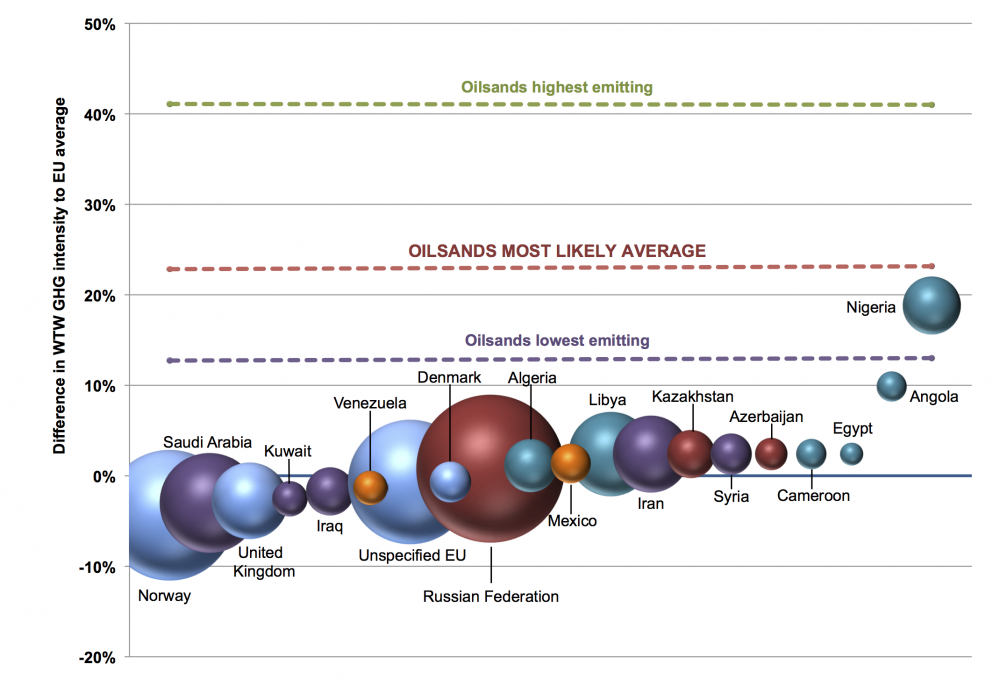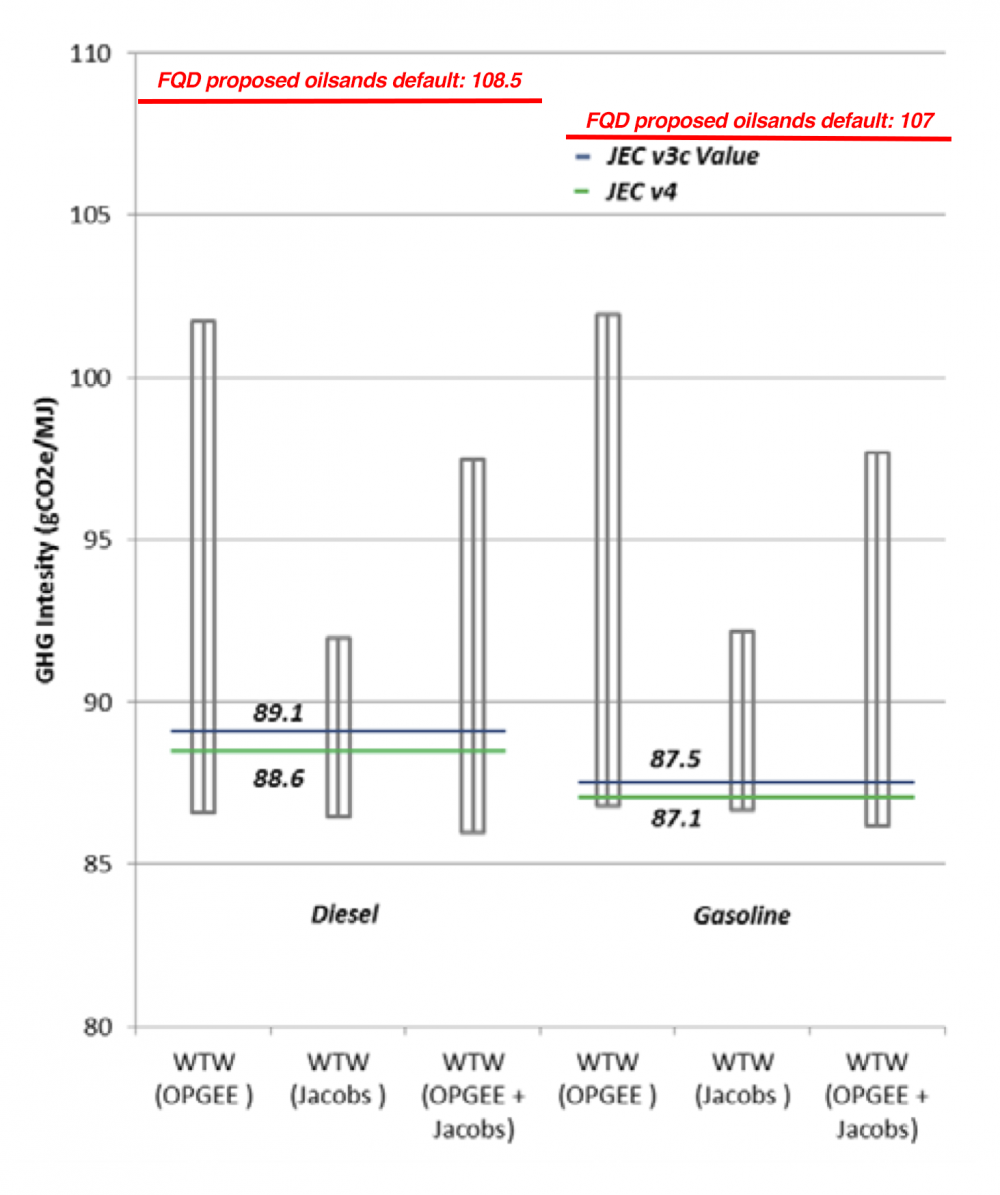Earlier this year, Natural Resources Canada (NRCan) commissioned a study to evaluate aspects of the European Union’s Fuel Quality Directive (FQD). Specifically, the study would assess the “default” carbon intensity value the European Commission is proposing to apply to fuels derived from conventional crude.
Canada has been lobbying very aggressively against the FQD, since fuels derived from natural bitumen (oilsands) would be assigned a higher carbon intensity value than those derived from conventional crudes.
What is the FQD?
The revised Fuel Quality Directive was passed into law in 2009 as part of the EU’s approach to reducing greenhouse gas emissions in the transportation sector. By 2020, it aims to reduce lifecycle emissions from transport fuels by six per cent. Detailed rules establishing the treatment of biofuels have already been passed and the European Commission is now doing the same for fossil fuels. More background on their approach can be found here and here.
A consulting firm called ICF International won the contract to produce the report. After $170,755 and seven weeks of work, the results are in: the report was released on Wednesday.
The spin machine at NRCan promptly went into overdrive, issuing a release titled “New Report Finds Fuel Quality Directive Ineffective.” Alberta’s Minister of International and Intergovernmental Relations Cal Dallas also issued a release making similar claims.
Despite the rhetoric, however, the report offers nothing to discredit the FQD. Rather, its findings seem to generally reinforce the defensibility of the Commission’s proposed approach.
Assessing the findings
There are hundreds of different sources of crude oil around the world, with a range of carbon intensities depending on how they are produced. Rather than attempting to assign a carbon intensity value to every possible crude source, the Commission’s proposal assigns average values to fuels based on their feedstock. Conventional crudes make up one feedstock with a common default value for their carbon intensity. Fuels derived from oilsands, oil shale, gas-to-liquids and coal-to-liquids represent other feedstocks, and each gets a separate default value. This is the same approach Europe has already taken to classify biofuels under the FQD.
The ICF study notes that carbon intensities of conventional crudes span across a range, which has always been clear. By using the feedstock approach, the Commission has sought a balance between no differentiation at all and attempting to establish a carbon intensity value for every single possible crude stream.
Carbon intensity of conventional EU refinery inputs by source country relative to average weighted value. Based on data from Brandt (2011), this figure shows the relative carbon intensity of various types of conventional crudes being imported to Europe, compared to their weighted average (the proposed default value, represented by the solid line at 0 per cent). The size of the circle represents the proportion of the total EU supply coming from this source. Source: Pembina Institute.
ICF also finds that the default GHG intensity values that the FQD assigns to fuels derived from conventional crude feedstock may be on the low end. The variation is largely driven by uncertainties in data coverage and emissions from venting, flaring and fugitives. Importantly, though, every single one of the FQD’s default values fall within ICF’s own range of most likely results. It’s possible that the default values may be slightly too low (particularly for gasoline) but, as the ranges make clear, they also may also be too high.

Comparison of FQD default values and ICF’s “Estimated Most Likely Range.” This figure shows ICF’s estimated ranges for diesel and gasoline average well-to-wheel (WTW) carbon intensity, produced based on different models. Blue lines represent the values used in the Commission’s FQD proposal. Proposed default values for oilsands are 108.5 and 107 gCO2e/MJ for diesel and gasoline, respectively. Proposed default values for oil shale (not shown above) are 133.7 and 131.3 gCO2e/MJ, respectively. Adapted from ICF.
All of the ranges produced by ICF for conventional crude fall well below the Commission’s proposed default values for fuels derived from natural bitumen (i.e. the oilsands). It’s clear that even under the worst-case assumptions for conventional crudes, average emissions for oilsands are still much higher. This doesn’t contradict the general soundness of the EU’s feedstock approach.
Building on the foundation
None of this is to say that the design of the FQD is perfect. However, it’s a sound first step, designed to be reviewed over time as better data becomes available.
ICF’s preferred approach of categorizing each individual crude is a sound goal to work towards. Greater differentiation is welcome, but it’s not a reason to delay implementation of the current proposal. Designing and implementing such a system from scratch would mean additional years of delay. That delay would postpone important incentives to reduce flaring and allow fuels derived from high-intensity oilsands and oil shale sources into Europe without corresponding offsets.
And it’s not clear that the Canadian government would be happy with the result either way. ICF’s approach would likely resemble California’s low-carbon fuel standard, something Canada has also lobbied against. No matter how the Commission decides to categorize different crudes, it's clear that the oilsands will be among the very highest emitters.
Instead of lobbying against climate policy in the EU, we’d prefer to see Ministers Joe Oliver and Cal Dallas advocating for real reductions at home. Without stringent regulations to curb emissions from the oil and gas sector, Canada will fall further out of step with an increasingly carbon-conscious global market.
No amount of reports and advertising campaigns can narrow the gap between bitumen and conventional crudes — only stronger environmental performance can do that.









